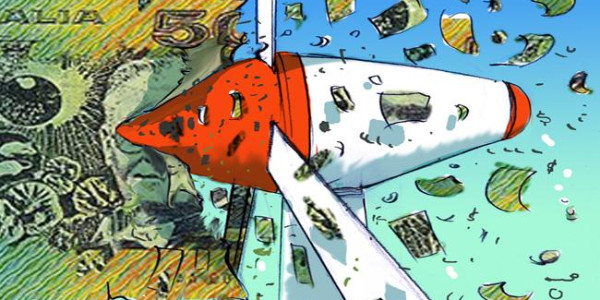HENRY ERGAS From: The Australian July 08, 2013 Illustration: Eric Lobbecke Source: The Australian GOOD on the Clean Energy Finance Corporation, the $10 billion fund established by Labor’s climate change package. Other government efforts at picking winners end up shafting taxpayers. The CEFC is doing so from the start. Not that the CEFC has released much information about its maiden “clean” energy project: the refinancing, announced last week, of Victoria’s $1bn Macarthur Wind Farm. But what is known makes intriguing reading. In theory, the CEFC is intended to address “barriers to funding cleaner energy projects”. But there is no evidence Macarthur couldn’t access capital. On the contrary, private investors offered the final tranche of finance the venture required, albeit at a slightly higher interest rate, reflecting the loan’s risk. Faced with that offer, the parties involved in Macarthur turned to the CEFC which, despite the government’s competitive neutrality obligations, undercut the private bid. That largesse was doubtless welcome; yet the beneficiaries, who fall into four groups, hardly seem natural recipients of Australian taxpayers’ generosity. The first are our cousins across the Tasman, with the CEFC’s intervention allowing New Zealand’s government-owned Meridian Energy to more profitably dispose of its investment in Macarthur prior to its privatisation later this year. A second beneficiary is AGL, Meridian’s partner in the venture. The CEFC previously described AGL as exercising “significant market power” in the purchase of renewable energy, meaning it extracts “super profits”; in adding a public subsidy to those profits, perhaps the CEFC was simply abiding by Matthew 13:12, “For whosoever hath, to him shall be given.” The Matthew principle applies with even greater force to the third recipient of the CEFC’s philanthropy, the Malaysian billionaire Syed Mokhtar al-Bukhary, who bought Meridian’s share. Syed Mokhtar’s links to Malaysia’s ruling party have facilitated the construction of a corporate empire that is investing in renewable energy worldwide. Last but not least is Macquarie Bank, with Macquarie Capital advising on the sale to Syed Mokhtar and managing Meridian’s float. With that cast of characters, the CEFC might have been expected to lean over backwards in demonstrating its intervention’s merits, all the more so as the CEFC’s chief executive and two of its board members are former senior employees of Macquarie, which gained directly from the CEFC’s decision. In fact, the sum total of the CEFC’s public disclosure amounts to a two-page press release claiming its funding will facilitate investment in wind generation. If the CEFC relied on a proper cost-benefit analysis, it hasn’t disclosed it; nor is it difficult to understand why: any reasonable appraisal would disclose a large social loss. That can be seen by undertaking the analysis the CEFC should have carried out. Assume that without the CEFC’s intervention, investment in wind generation would decline an implausibly large 10 per cent. That capacity would be replaced by a gas-fired plant, causing greater carbon emissions. By preventing that shift, the CEFC can claim a social benefit; but even assuming the carbon price understates the social value of abatement by $3 per tonne, that benefit is no greater than $6.6 million a year. However, like all bailouts, the CEFC’s will weaken the incentives for wind projects to be selected and operated efficiently. Even if their efficiency only declines by a mere 5 per cent, the social loss would be nearly four times larger than the $6.6m benefit. And to that loss must be added the higher cost of wind generation per unit of power supplied, further offsetting the environmental gain. The aggregate result is that for each $1 of benefit, the CEFC’s intervention makes Australians $5 worse off. That outcome highlights the extent to which carbon policy has degenerated into a mechanism for redistributing income from taxpayers and electricity consumers to favoured constituencies, imposing steep economic costs along the way. And if the CEFC reflects that phenomenon in microcosm, the carbon tax embodies it on a vast scale. After all, prices in European carbon markets have been far below our initial $23 tax since it came into effect. Abatement could therefore have been purchased internationally at a fraction of the cost the carbon tax has imposed on Australian industry. And the consequences of forcing emissions reductions here that could have been done more cheaply elsewhere have been anything but trivial. Rather, Treasury’s own modelling, adjusted for the absence of an integrated world carbon market, suggests that had our tax been aligned with Europe from the outset, national income would be $3.5bn higher by the end of 2014-15. Moreover, over the same period, households would have paid $4.2bn less in electricity prices, saving $450 per household. Why then has the tax remained at such high levels? Because decreasing it to European prices would have slashed government revenues over the period to 2014-15 by $12bn. It would thus have limited the scope to curry favour through tax cuts and the allocation of free permits, cash handouts and exemptions. And it would have provided a far smaller implicit subsidy to the renewable energy industry, which has been the carbon policy’s most vocal supporter. All that points to a crucial lesson: despite the incessant chatter about “market mechanisms”, this policy is an entirely artificial government construct, lacking any anchor linking the burdens it imposes to any gains it creates. In contrast to normal markets, prices can therefore continue indefinitely at levels which do not balance benefits with costs. And in the penumbra of the cash flows it generates, questionable deals can be struck with private interests at taxpayers’ expense. These deficiencies are not minor flaws; they are integral to the system Labor has set up. Until a clean broom is brought to this area, expect decisions such as the CEFC’s to remain the order of the day. Taylor Scott International
Carbon Folly Comes At A Price

This entry was posted in Investment, investments, News, Property, Taylor Scott International, TSI, Uk and tagged australian, calendar, carbon, cefc, europe, european, illustration, investment, javascript, price, property. Bookmark the permalink.







